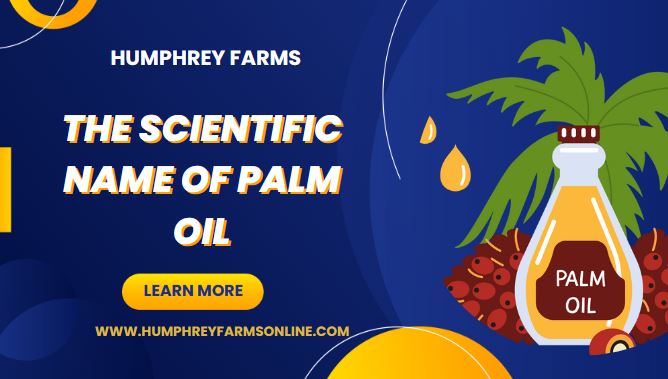
Scientific Name Of Palm Oil: When you think of palm oil, the first thing that might come to mind is its versatility in cooking and manufacturing.
But have you ever wondered about the plant behind this popular oil? Let’s delve into the scientific name of palm oil and explore its characteristics, uses, and the environmental issues surrounding it.
Also, Read
Are Palm Oil And Coconut Oil The Same?
Palm Oil Vs Vegetable Oil: The Health Debate You Need to Know
What Is Palm Oil?
Palm oil comes from the fruit of the oil palm tree, scientifically known as Elaeis guineensis. This tree is a member of the palm family (Arecaceae) and is primarily grown in tropical regions, especially in West and Central Africa, as well as in countries like Malaysia and Indonesia.
Characteristics of the Oil Palm
- Height: The oil palm typically reaches heights of about 20 meters (66 feet).
- Fruit: The tree produces a large cluster of oval fruits, each around 4 cm (1.6 inches) long. When ripe, these fruits are black with a reddish base and contain a single oily seed called the kernel.
- Flowers: The oil palm bears numerous tiny flowers that cluster on short branches, eventually developing into the fruits we harvest for oil.
How Is Palm Oil Extracted?
The process of extracting palm oil involves a few key steps:
- Steaming: The outer fleshy portion of the fruit is steamed to deactivate lipolytic enzymes.
- Pressing: The steamed fruit is then pressed to extract the palm oil, which is rich in carotenes, giving it a vibrant color.
- Kernel Oil: The seeds (kernels) are separately pressed using mechanical screw presses to obtain palm kernel oil, which differs chemically from the oil derived from the flesh.
Uses of Palm Oil
Palm oil is incredibly versatile and can be found in a variety of products:
- Food Products: It’s commonly used in margarine, ice cream, chocolate, cookies, and bread.
- Cosmetics: You’ll find it in soaps and other personal care items.
- Industrial Uses: Palm oil is also utilized in biofuels and lubricating greases.
The Byproducts
After extracting palm kernel oil, the leftover cake residue is often used as cattle feed, showcasing the oil palm’s multifaceted utility.
Environmental Impact
While palm oil production has its benefits, it comes with significant environmental concerns:
- Deforestation: The rapid expansion of palm oil plantations has led to large-scale deforestation in regions like Indonesia and Malaysia. This has threatened wildlife, particularly iconic species such as the Bornean and Sumatran orangutans.
- Slash-and-Burn Practices: New plantations are often established using slash-and-burn methods, which contribute to poor air quality and habitat loss.
- Sustainability Issues: Although efforts are being made to promote sustainably grown palm oil, the adoption has been slow among corporate buyers. Many environmental advocates urge consumers to be cautious about products containing palm oil.
Other Species
Interestingly, there are other palm species, such as the American oil palm (Elaeis oleifera), which is native to Central and South America. This species has a creeping trunk and flat leaves, and while it can also produce oil, it’s not as widely used as Elaeis guineensis.
What Is The Scientific Name For Palm Oil?
When it comes to palm oil, it’s important to know where it comes from. This edible vegetable oil is extracted from the fruit of oil palm trees, and its scientific name is Elaeis guineensis.
This name refers specifically to the African oil palm, which is the primary source of palm oil used in cooking and many processed products. So, next time you see palm oil on a label, remember that it originates from Elaeis guineensis!
What Is The Real Name Of Palm Oil?
So, what’s the real name of palm oil? It actually comes from the oil palm tree, which is scientifically known as Elaeis guineensis. This tree originally comes from West Africa and has recently been introduced to places like India.
What makes oil palm special is its ability to produce a lot of oil in a small area, making it one of the highest-yielding vegetable oil crops.
From this tree, we get two different types of oils: palm oil, which is used in cooking and food products, and palm kernel oil, which is used in both culinary and industrial applications.
What Are 5 Different Names For Palm Oil?
Palm oil is known by several names, especially when referring to its different forms and uses. Here are five different names you might come across:
- Palm Kernel Oil (PKO): This oil comes specifically from the seeds of the oil palm fruit and is often used in cooking and manufacturing.
- Palm Kernel Stearin (PKs) and Palm Kernel Olein (PKOo): These are fractionated forms of palm kernel oil, separated to create oils with different properties for various uses.
- Partially Hydrogenated Palm Oil (PHPKO): This type of palm oil has undergone a process that changes its chemical structure, often making it more solid at room temperature.
- Fractionated Palm Oil (FP(K)O): This refers to palm oil that has been separated into different components, allowing for specific qualities suited for particular applications.
- Organic Palm Kernel Oil (OPKO): This is palm kernel oil produced from organically grown oil palms, appealing to those looking for environmentally friendly options.
These names reflect the versatility of palm oil and its various applications in cooking, food production, and even cosmetics!
What Is The Nickname For Palm Oil?
What Is the Nickname for Palm Oil?
When you’re checking the labels on food products, palm oil might show up under a few different names. A good way to remember this is to look for these four main terms:
- Palm: You might see it in names like Ethyl Palmitate or Ascorbyl Palmitate (304). These indicate that palm oil or its derivatives are present.
- Stear: This can appear in names like Aluminium Stearate or Diisostearyl Malate, which also point to palm oil derivatives.
So, while “palm oil” is the common name, keep an eye out for these variations on labels to know when palm oil is included in a product!
Conclusion
The scientific name of palm oil, Elaeis guineensis, represents more than just a plant; it highlights a complex relationship between industry and the environment.
While palm oil serves as a crucial resource in many sectors, it’s important to consider its ecological impact and choose sustainably sourced products whenever possible.
Understanding this plant helps us appreciate the balance we need to strike between our consumption and environmental responsibility!

Leave a Reply
You must be logged in to post a comment.